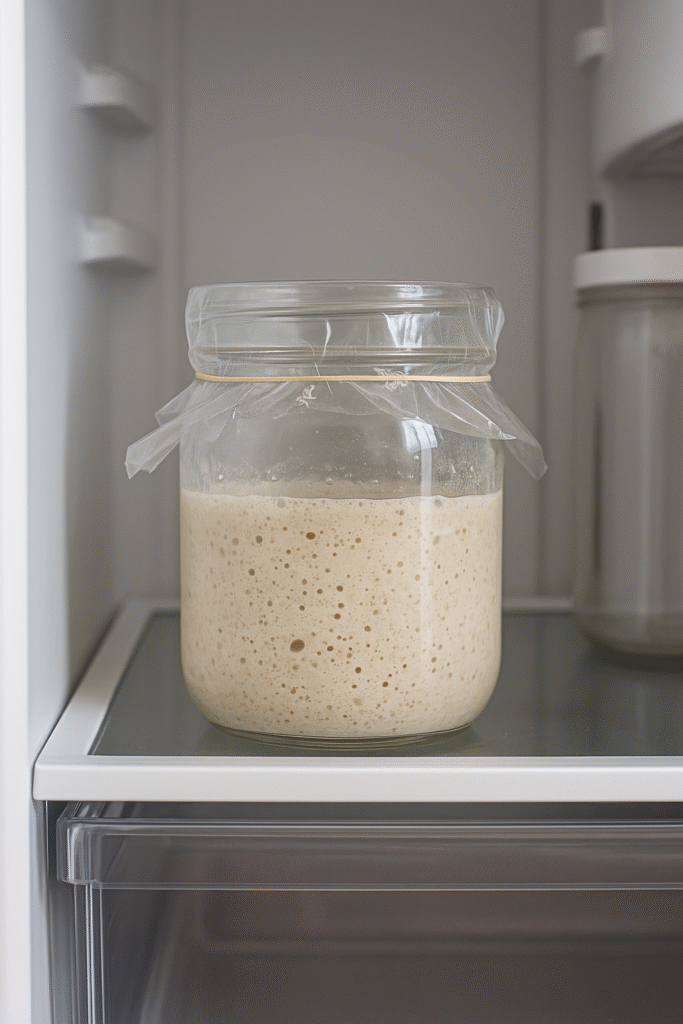Storing Sourdough Starter for Long-Term Use
Sourdough starters, once established, can keep almost indefinitely with proper care. But what if you want to take a break from baking, go on an extended vacation, or just want to keep a backup of your precious starter? Here’s your guide to storing your sourdough starter for long-term use.
Storing Sourdough Starter in the Refrigerator
If you’re planning to take a break for a few weeks to a couple of months, storing your sourdough starter in the refrigerator is your best option. Here’s how you do it:
-
-
Feed your starter as you usually would and let it sit out at room temperature until it’s bubbly and active.
-
Once it has peaked (risen at its highest point), stir it to deflate, then cover it tightly.
-
Place it in the refrigerator. The cold temperature slows down the yeast activity, putting your starter in a state of “hibernation.”
-
Your starter can comfortably sit in the fridge for a week or two. However, for long-term storage of a month or more, it’s best to feed it every 2-4 weeks. Remove the starter from the refrigerator, let it come to room temperature, feed it as usual, and then return it to the fridge once it has peaked again.
Freezing Your Sourdough Starter
For periods of absence longer than a couple of months, you might consider freezing your sourdough starter.
-
-
-
Feed your starter and let it peak, as mentioned above.
-
Stir your starter to deflate, then spread a thin layer on a piece of parchment paper or a silicone baking mat. You can also freeze small portions in ice cube trays.
-
Once the starter is frozen solid, break it into pieces or remove from the ice cube tray and store in a freezer-safe bag or container.
-
When you’re ready to revive your starter, thaw it in the refrigerator or at room temperature, then feed it as usual. It might take a few feedings for your starter to regain its normal activity level.
-
-
Drying Your Sourdough Starter
Drying your sourdough starter is another great option for long-term storage and also serves as a backup in case anything happens to your active starter.
-
Feed your starter and let it reach its peak activity.
-
Spread a thin layer of your active starter onto a silicone baking mat or parchment paper.
-
Let it air dry at room temperature. This process may take several days, depending on the temperature and humidity.
-
Once completely dry, break the dried starter into flakes and store them in an airtight container.
-
To rehydrate your starter, combine a portion of the dried flakes with equal parts water by weight and let it sit at room temperature. Once fully hydrated, begin regular feedings. It might take several feedings for the starter to return to its full vigor.
The Science Behind Sourdough Starter Storage
To fully understand why these storage methods work, it’s important to understand what’s happening within the sourdough starter at a biological level. A sourdough starter is a symbiotic culture of yeast and lactic acid bacteria (LAB), with each of these organisms playing a crucial role in the fermentation process that gives sourdough its unique characteristics.
When we feed the starter with flour and water, we’re providing food for both the yeast and the LAB. The yeast consumes the sugars in the flour, producing carbon dioxide and alcohol, which causes the starter to rise and imparts a distinctive flavor. Simultaneously, the LAB feed on the byproducts of the yeast fermentation, producing lactic and acetic acids, which contribute to the tangy flavor and enhanced shelf life of sourdough bread.
Storing the sourdough starter in the refrigerator, freezing it, or drying it out all work by slowing down the activity of these organisms.
Refrigeration: When the starter is stored in the refrigerator, the cooler temperatures slow down the metabolic processes of the yeast and LAB. The organisms enter a dormant state, or “hibernation,” as it were, where they continue to live but their activity is significantly reduced. This is why you can leave your starter in the fridge for extended periods. However, the yeast and bacteria will eventually exhaust their food supply, so periodic feedings are necessary for long-term refrigeration.
Freezing: Freezing your sourdough starter essentially puts the yeast and LAB into a deep freeze, halting their activity completely. While some cells may not survive the freezing and thawing process, enough usually do to allow the culture to be revived with regular feedings. It’s like reawakening them from a long sleep.
Drying: Drying the sourdough starter removes the water that the yeast and LAB need to carry out their metabolic activities. In this way, the starter can be preserved for a long time, as long as it’s kept dry. Rehydration restores the environment needed for these organisms to become active again.
In all these methods, the key principle is that we’re altering the environment of the starter to slow down or halt the metabolic activity of the yeast and LAB, preserving them in a state that can be revived when desired. Always remember to be patient during the revival process. It may take some time for the yeast and LAB to recover and return to their peak activity levels.
